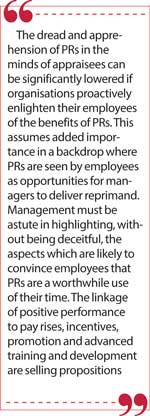Friday Jul 05, 2024
Friday Jul 05, 2024
Monday, 1 July 2024 00:22 - - {{hitsCtrl.values.hits}}

Employees must believe that PRs are fora where they can openly discuss their needs and concerns
 A pulse check of corporate Sri Lanka reveals that there are mixed feelings about the appropriateness and effectiveness of Performance Reviews (PRs). While there are some who swear on the positive role which PRs play through their focus on goal setting, performance monitoring and employee development under an overarching umbrella of performance management, there are others who believe that PRs do more harm than good because they are not conducted methodically, transparently and/or democratically and because they are too focused on the past, time-wasting, one-sided, inaccurate, unfair, pre-meditated and biased.
A pulse check of corporate Sri Lanka reveals that there are mixed feelings about the appropriateness and effectiveness of Performance Reviews (PRs). While there are some who swear on the positive role which PRs play through their focus on goal setting, performance monitoring and employee development under an overarching umbrella of performance management, there are others who believe that PRs do more harm than good because they are not conducted methodically, transparently and/or democratically and because they are too focused on the past, time-wasting, one-sided, inaccurate, unfair, pre-meditated and biased.
The PRs which, in most corporates, have taken the form of annual, inanimate rituals are known to challenge the objectivity of even the most battle-hardened appraisers and trigger dread and apprehension in the appraisees. In a typical PR, the appraisee’s performance is usually distilled into a numerical rating which conveys whether his/her performance and/or the organisation’s performance was average, below average, or above average during the period under review. These ratings oft serve as the basis of incentive payments, salary increments, promotions, talent management, training and development and succession planning, amongst others.
Given the power of one number influencing their future, it is not surprising that appraisees view performance reviews with dread, apprehension and trepidation and, therefore, demand that the determined numeric represents the true and fair picture. While the merits, and demerits, of numeric performance ratings have been bones of discontent over many decades, closer scrutiny will reveal that it is really the design, construct and conduct of the PRs, the methodology of the rating calculation and the way such ratings, observations and comments are communicated which give birth to employee satisfaction or dissatisfaction.
A PR, in its authentic form, is a formal evaluation of an employee’s performance and achievements against pre-agreed goals and objectives. It is also an assessment of the skills/competencies displayed by him/her in his/her job role during a specified window of time. Most organisations conduct them annually. It also serves as a forum where a supervisor and his/her reportee can discuss where they are doing great, where they can do better and where a different approach is warranted and through such discussion agree on a Performance Improvement Plan (PIP), this being a formal document which outlines the reportee’s performance gaps along with a time-lined, goal-oriented plan to help him/her improve.
My own experience of performance reviews, though a mixed bag in the early stages of my career, is now a definite positive. This is possibly an outcome of having been very closely involved both as an individual and as a member of various ‘think’ tanks and project teams, in Sri Lanka and globally, which implemented PR systems and studied PR systems in making them more objective, transparent and therefore more credible and by being an active advocate of integrated performance management where PRs of teams and individuals play a vital role. This article, which is based on my corporates experience, highlights the aspects which must be given specific attention in making PRs a value-adding element of a performance management system.
An essential first step
A clear communication of the organisation’s vision, mission, purpose and values to all employees, not to just the big boys, is an essential first step in aligning the various divisions and departments of an organisation to a common goal and inspiring in them a shared vision. There is no one who is unimportant! Use words, symbols, pictures and forms of communication which are meaningful and relevant to the different levels. The vision, mission and purpose define what the organisation stands for, what it aims to achieve and how it will be achieved. They act as guardrails of the operating model of, and the general conduct and performance of individuals in, the organisation. Posters, banners, stickers, meetings, intranet, newsletters, blogs, social media, video podcasts, webinars et cetera are tools which can be used in facilitating awareness, feedback and dialogue.
 The dread and apprehension of PRs in the minds of appraisees can be significantly lowered if organisations proactively enlighten their employees of the benefits of PRs. This assumes added importance in a backdrop where PRs are seen by employees as opportunities for managers to deliver reprimand. Management must be astute in highlighting, without being deceitful, the aspects which are likely to convince employees that PRs are a worthwhile use of their time. The linkage of positive performance to pay rises, incentives, promotion and advanced training and development are selling propositions. By correlating their roles to the organisation’s vision, mission and purpose, management can help employees appreciate the ‘why’ of their efforts and outputs and thereby create a sense of belonging.
The dread and apprehension of PRs in the minds of appraisees can be significantly lowered if organisations proactively enlighten their employees of the benefits of PRs. This assumes added importance in a backdrop where PRs are seen by employees as opportunities for managers to deliver reprimand. Management must be astute in highlighting, without being deceitful, the aspects which are likely to convince employees that PRs are a worthwhile use of their time. The linkage of positive performance to pay rises, incentives, promotion and advanced training and development are selling propositions. By correlating their roles to the organisation’s vision, mission and purpose, management can help employees appreciate the ‘why’ of their efforts and outputs and thereby create a sense of belonging.
Employees must believe that PRs are fora where they can openly discuss their needs and concerns. On the other hand, supervisors must project themselves as ‘listeners’ rather than fault finders and correctionists. Corporate leaders must convince employees that PRs will lead to meaningful change for them and the organisation. In the absence of that, employees will participate in PRs with an obligatory, pessimistic, and even aggressive attitude and the PR will be a waste of time. It is my observation that most corporates in Sri Lanka do not make that extra effort in communicating to employees the benefits of PR.
At the heart of PRs is the regular monitoring of progress against Key Performance Goals (KPGs) and Key Performance Indicators (KPIs). Key Performance Goals (KPGs) are long term strategic benchmarks against which overall company performance, division or departmental performance or a specific team performance are tracked. Key Performance Indicators (KPIs) have shorter time horizons, generally not exceeding a year, and are performance targets which arise out, and are a sub-set, of the KPGs. KPIs must not be set unilaterally. The employee and his/her immediate supervisor must, ideally, agree on the individual KPIs.
These must be expressed in terms of unit of measurement, value, timing, data source, measurement method et cetera and must fit with SMART principles, these being the principles of Specific, Measurable, Achievable, Relevant and Time-bound. If, and when, there is no agreement, the supervisor must use his leadership and judgement skills and set an indicator which is consistent with the company’s, division’s, department’s, or team’s KPIs. KPIs must be in place before the commencement of the period which they relate to. Rules must not be changed once the game has started unless both parties agree. If rules are changed without agreement, the KPIs and consequently the PRs will lose their credibility and will give rise to employee suspicion and dissatisfaction.
Tendency to set a plethora of KPIs
There is a great tendency for management to set a plethora of KPIs. Management seems to believe that more is better. The clutter created by such excess will inevitably lead to a dilution of focus. My strong advice is that KPI setting follows the Pareto Principle where 80% of the outcomes come from 20% of the causes. In this way, do not have more than six KPIs. KPI statements must be easy to understand and unambiguous and must be documented and signed off by the parties. In my experience, ‘data source’ and ‘measurement method’ are points of frequent disagreement between the appraiser and appraisee. Avoid this by being very specific in defining them. Revisions to KPIs are in order when circumstances justify, particularly when there are unanticipated changes in the macroenvironment.
Needless to state, such revisions must be mutually agreed on and must be clearly documented. KPI agreement is serious stuff and management must ensure that policies, procedures and processes covering it are clearly articulated and well disseminated. As a point of note, Objectives and Key Results (OKRs), a framework created by Andrew Grove at Intel has been mentioned, in recent times, as an alternative to KPIs. Whilst they are both used in performance management, their aims differ. KPIs track performance and are based on past results. OKRs are goal-setting frameworks which are used to develop new capabilities in a team and guide company growth. OKRs generally address aspects which are currently not in play.
Effective and timely feedback is in my view the most critical driver of performance. The quality of feedback is the make or break of PRs. PRs will deliver the desired results only if employees know, in a timely manner, how they are doing, what is working and what is not working. It is such discourse which spawns timeous course corrections which are inevitable in a volatile world such as what exists now. The timely, honest, transparent, and constructive two-way feedback is a powerful feature of a value delivering PR system. While ‘annual feedback’ is the order of the day in most organisations, I would unhesitatingly advocate a practice of continuous feedback interspersed between two formal feedback meetings at mid-year, and post year end.
One may be heard to say, “I hardly have time to perform my day-to-day work, so how can I find the time to do all this.” Here lies the biggest impediment to developing human resources in corporate Sri Lanka. Leaders and managers who are quick to sing the praises of their staff in public, rarely find the time to give and receive feedback at the workplace. While I acknowledge that the customer is king, if managers and leaders devote one tenth of the time they spend with customers and clients in giving feedback and developing their subordinates, the well-being it would engender will cause unimaginable improvement in employee productivity and consequent service delivery to customers. Neglect of subordinate development is a malady which afflicts the corporate world both locally and globally.
Leaders and managers who unhesitatingly spend millions on ‘lifeless’ fixed assets which have limited capacities are reluctant to spend significantly less in enhancing the capacity and capability of their human capital. For those who complain that they do not have the time to develop and motivate their staff, I suggest that they do Management by Wandering Around (MBWA), an approach famously used by William Hewlett and David Packard, founders of Hewlett Packard, where leaders, and managers, regularly leave their desks and connect, unannounced, with their team members in giving and receiving feedback in settings which are less intimidating. Feedback must be given in a manner which will best help improve performance.
While feedback must be accurate, factual and complete, it is most effective when it consists of both the good and the bad. Connecting PR feedback to training and development is a powerful way of making employees valued. Notwithstanding the previously mentioned, continued poor performance despite steps taken to redress must lead to sterner actions including severance as a last resort.
Career Committee
 The final and formal performance appraisal must not be based on a ‘one-on-meeting’. It is vital that corporates prevent situations where an employee is at the mercy of a supervisor who dislikes him/her for reasons other than actual performance. A good practice is where a Career Committee is used in the formal, year-end performance appraisal. The typical Career Committee will comprise of the supervisor, persons other than the supervisor who are familiar with the appraisee’s role deliverables, a representative from the Human Resources (HR) Division and an observer/moderator who ensures that the process is followed.
The final and formal performance appraisal must not be based on a ‘one-on-meeting’. It is vital that corporates prevent situations where an employee is at the mercy of a supervisor who dislikes him/her for reasons other than actual performance. A good practice is where a Career Committee is used in the formal, year-end performance appraisal. The typical Career Committee will comprise of the supervisor, persons other than the supervisor who are familiar with the appraisee’s role deliverables, a representative from the Human Resources (HR) Division and an observer/moderator who ensures that the process is followed.
A ‘best practice’ PR process is as follows. * Employee and superior agree the KPIs and other evaluation criteria before the commencement of the specified period, * The agreed KPIs are entered into a Human Resource Performance Management system. The captured data is ‘frozen’ and can be only changed with the authority of nominated persons, * During the specified period the supervisor gives continuous feedback both formally and informally and keeps notes, * At mid-year, the employee completes a self-appraisal in the system. The supervisor, too, does an appraisal. A review and discussion take place between superior and employee.
A person from HR will be in attendance as necessary, * Post year-end, the employee does a self-appraisal in the system. The supervisor does his/her appraisal of the employee in the system, * The supervisor appears before the Career Committee to justify his ratings, * The ratings and comments of the Committee are documented. A PIP and/or a Training and Development Plan are included. Other pertinent comments are also captured, * A summation of the individual ratings are forwarded to an appointed higher authority who examines the reasonableness and logic of the ratings, * A summary of the distribution of ratings by level is perused by the Top Team with a view to ensuring inter-divisional and corporate equity, * A feedback document is prepared for each individual employee, * A formal feedback discussion takes place between the supervisor and individual with a representative from HR in attendance as a ‘notes’ taker and an independent senior manager as an observer/moderator, * Individuals are given the opportunity to make an appeal to a grievance committee if they feel hard done, * The performance ratings become the base which is used in calculating short-term incentives, awarding increments, promotions, lateral transfers, training and development, talent pooling and succession planning, * An employee who scores ‘below expectation’ is placed on a strict PIP. An employee who is rated ‘below expectation’ two years in succession is, in general, put on an exit mode.
Performance review follow up is just as important as the review itself. Performance review follow-up helps ensure that feedback translates to action, improvement, and growth. The year-end review is a great starting point. By now, it is abundantly clear that a lot of preparation is required if PRs are to be effective. It is a tool which much be taken seriously and practiced with objectivity, diligence, commitment, sensitivity, love and caring. It must not be a ‘box-ticking’ exercise, which sadly, appears to be the case with most corporates in Sri Lanka. When implemented well, performance reviews enhance performance, align individual aspirations with the organisation’s goals and add oomph to the employees’ careers. When done poorly, PRs hasten their departure.
In summation, and in broad terms, the common pitfalls of PRs are, * Inadequate preparation, * Over reliance on peer feedback and the corporate grapevine, * Poor feedback, * One-sided conversations, and * Lack of follow-up, both structured and unstructured. Performance Review or Performance Evaluation is a critical aspect of Performance Management in driving an organisation’s success. It is a great tool in assessing the performance of employees, identifying areas for improvement, and recognising and rewarding above average performers. Effective goal setting, process driven assessments, informal and formal feedback and guidance interspersed with process dictated formal reviews promote employee engagement and empowerment, catalyse organisational productivity, and help establish a culture of continuous upgrading.
If managers and leaders cannot find time to contribute to the development of their reportees, it can only mean two things. His/her span of control is too wide, or he/she is not cut out to be a leader or manager. As was stated by Stephen R. Covey, “Always treat your employees exactly as you want them to treat your best customers.” Effective leaders do not treat employees as ‘Cinderellas’.
(The writer is a Leadership Coach, Mentor and Consultant, and boasts over 50 years of experience in very senior positions in the corporate world – local and overseas. www.ronniepeiris.com)